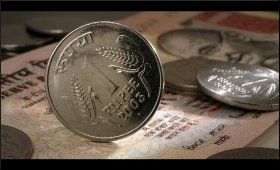|
|
|

|
Rupee may continue to remain weak on volatility in global markets
|
|

|
|
| Top Stories |
 |
|
|
|
SME Times News Bureau | 09 Oct, 2019
The Indian rupee is likely to
continue its weak trend against the dollar due to a probable rise in
volatility in the international financial markets.
According to
the Reserve Bank of India's (RBI) Monetary Policy Report for October
2019, rising protectionism, slowdown in global trade may increase
volatility in the financial markets.
"The INR depreciated
vis-a-vis the US dollar in August 2019, reflecting global developments.
Looking ahead, rising trade protectionism, slowing global trade and
global output could increase volatility in the international financial
markets and exert further downward pressure on the currency," said the
report.
It noted that if the rupee depreciated by 5 per cent
from the baseline, inflation could edge up by around 20 basis points
(bps) and boost net exports and GDP growth by around 15 bps.
The
report further said that a slew of measures taken by the government to
boost output and investment, policy reforms in the FDI (foreign direct
investment) regime, and greater than expected monetary policy
accommodation by the central banks in major advanced economies (AE) may
attract increased capital inflows and lead to an appreciation of the
rupee.
An appreciation of the rupee by 5 per cent could moderate
inflation by around 20 bps and GDP growth by around 15 bps from the the
baseline, it said.
The Indian rupee has largely been subdued and depreciated in the past few months. Currently, it is trading over 71 per dollar.
Outflow
of foreign funds has also hampered the movement of rupee. Foreign
Institutional Investors (FII) sold Rs 3,286.42 crore in October so far.
According
to the report headline inflation is projected to remain below the
medium-term target of 4 per cent over the rest of 2019-20 and the early
months of 2020-21.
"Volatility in international and domestic
financial markets, as well as global crude oil prices, and domestic
prices of perishable food items pose upside risks to the baseline
inflation path. On the other hand, the softer outlook on global
commodity prices and large buffer stocks could keep headline inflation
below the baseline," it said.
|
|
|
| |
|
|
|
|
|
|
|
|
|
|
|
|
|
|
| |
| Customs Exchange Rates |
| Currency |
Import |
Export |
US Dollar
|
₹88.70
|
₹87 |
UK Pound
|
₹119.90
|
₹116 |
Euro
|
₹104.25
|
₹100.65 |
| Japanese
Yen |
₹59.20 |
₹57.30 |
| As on 30 Oct, 2025 |
|
|
| Daily Poll |
 |
 |
| Who do you think will benefit more from the India - UK FTA in the long run?
|
|
|
|
|
|
| Commented Stories |
 |
|
|
|
|
|
| |
|